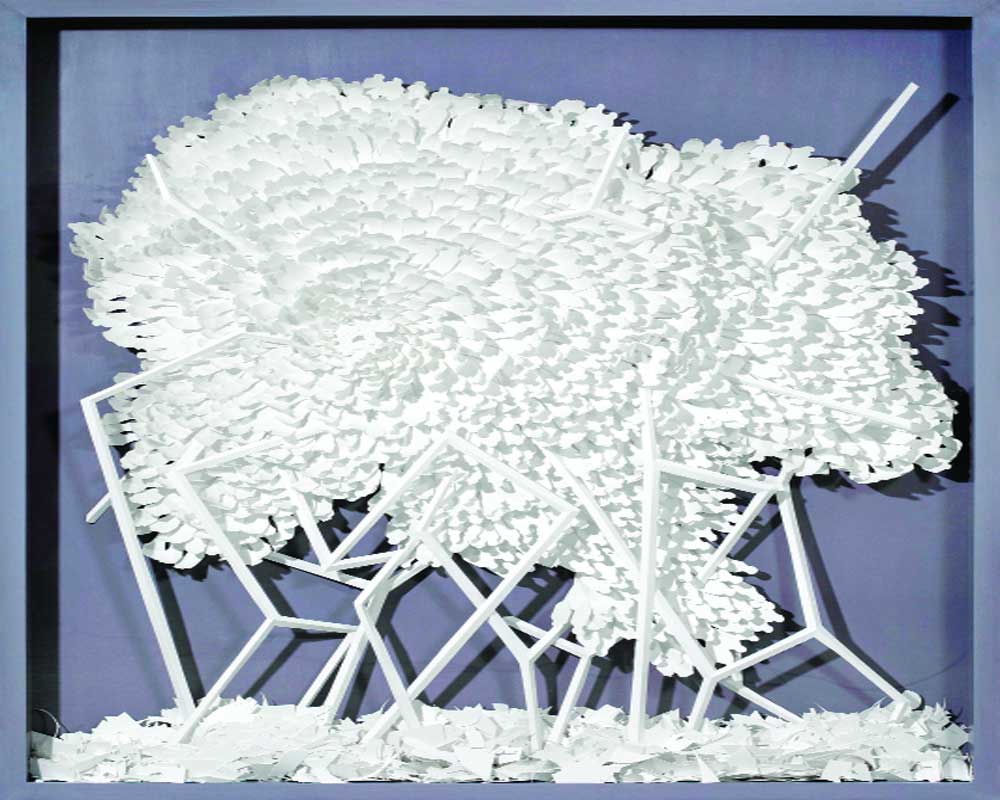Paper works by artistes Ankon Mitra and Sachin George Sebastian stir the aesthete in you, says Uma Nair
An ode to the power of paper, Art Motif is a riveting exhibition that translates the eternal beauty of white into evanescent creations. Among the artistes on view, one must zoom in on the tool that two stalwarts employ, a humble pair of scissors. Between Shanghai Biennale-returned Ankon Mitra and Sachin George Sebastian, we are looking at new thoughts and contemplative idioms.
Sachin’s metamorphosis
Sachin’s works at Art Motif belong to his series Sites of Metamorphosis, which were earlier seen at the Vadehra Art Gallery. This Communication Design graduate from National Institute of Design (NID), Ahmedabad, was first discovered by Pooja Sood of Khoj, who gave him a residency. Sachin creates a cohesive language when he gives us his own ideas of the city taking hold of the consciousness of its inhabitants. It presents a materiality that is carried forward beyond the boundaries of the city.
In an interview in 2016, he said, “A city is about experiences related to change. We humans undergo transformations and trace it to multiple sites, the inner space within us and the physical manifestation outside of us. I have been working for a few years on the notion of how a city continually undergoes transformation and how even the subjects change. Within the deep and obvious set of transitions, some people are able to deal with it, while some struggle and a few rise above the others. We also see a city defined by those who change themselves and those who change the city. It is very difficult to draw the line between them. My work is focussed on this amalgam.” For him, the act of cutting with a pair of scissors is interpreting the matrix of change.
The city is Sachin’s leitmotif. It is interesting to see that with a Zen synergy, he contains the grammar of formal engagement to explore the emotional and psychological aspects of urban living. The cut paper looks spectral even as it hints at tracing transformations in the city, etching in dulcet dualities of light and shadow the fabric of existence through architectural elements and hints of urban accents.
Sachin’s Sites of Metamorphosis remind one of building blocks piled one on top of the other. But given the fact that it is not made of a sturdy material, they tend to bunch up in curved lines.
His untitled work displays a complicated floral motif which certainly had a carnation-like quality making it attractive and ethereal in equal measure.
The effect, therefore, is deeply contemplative as well as immersive in the language of silence and meditation.
Ankon’s folded aesthetic
Architect, landscape designer and oritecture (an amalgam of architecture and origami) genius, Ankon presents an aesthetic that depicts the lines of folding, unfolding and weaving in nature’s forces. The larger installation on the wall can mirror a thousand things while it is the three latticed bells that remind us of the finest cathedrals of the world like the Nortre Dame and many others.
For a lover of Noguchi lamps, these Bells of Light speak about the intensity and stamp of time and style. Over the years, Ankon’s interest and vocabulary in the origamic tradition has expanded his understanding of spatial effects, interior designs, materials and forms. He follows the footsteps of the great Japanese Master Noguchi, who intended his art to serve both practical and social functions with his sculptural style, exerting a lasting influence on the idiom of organic design and weightless luminosity. Ankon’s lanterns and bells remind one of the word akari, which means “light” in Japanese, connoting both illumination and physical lightness.
The works present a sculptural identity suffused with lithe, latticed light fragments. The light adds a luminosity that is laced with part opacity and translucence. The pristine passion of working with paper unleashes a marriage of precision and hand-made details. It is wrong to use the term craft for these lanterns and bells. The sculptural symbolism is seen in the accuracy and meticulous mooring of the folds, the slits and the Issey Miyake type pleats that either radiate or fall like an inverted lily bloom.
Paper can create architectural distinction and can qualify the beauty of quiet light. Paper is about variety, simplicity, translucence and silence. It can, in its essence, create an ephemeral signature that illuminates the mind.
Ankon’s and Sachin’s works stir the aesthete in you. At best, this show of paper brings back the words of artist Isamu Noguchi — “The harshness of electricity is thus transformed through the magic of paper back to the light of our origin, the sun, so that its warmth may continue to fill our rooms at night.”


























